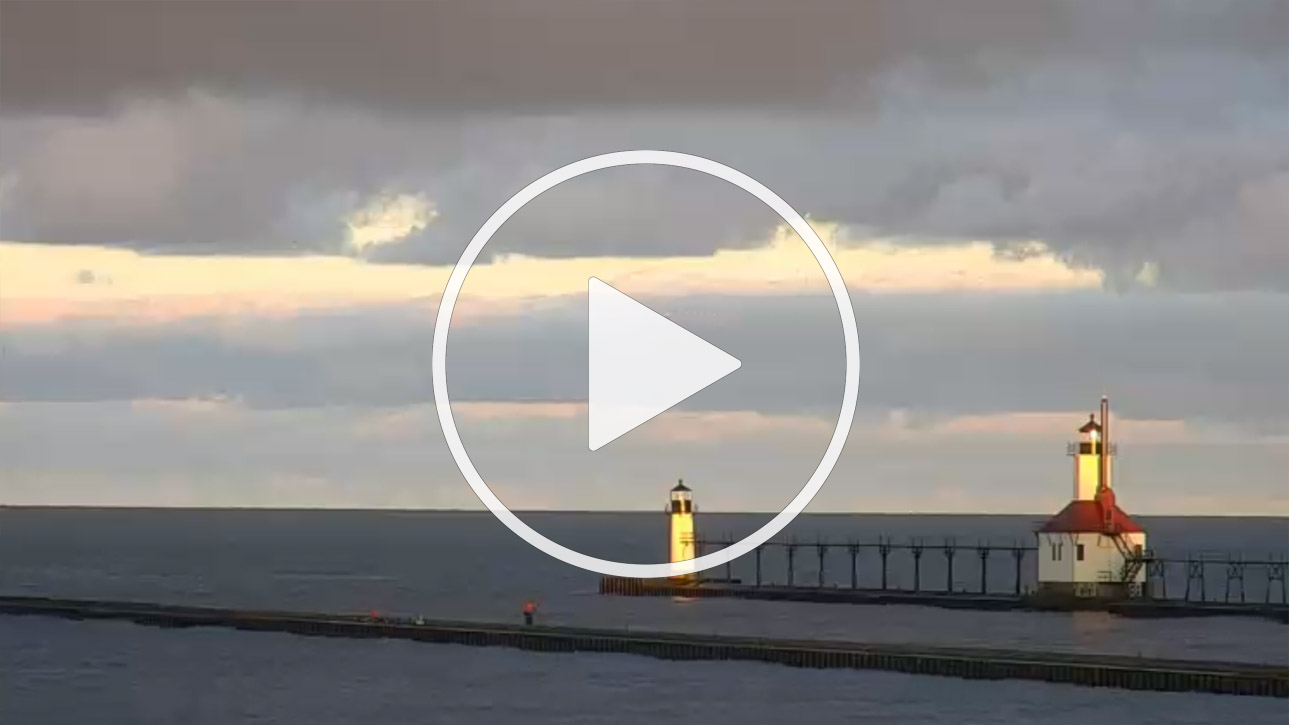Silver Beach County Park Live Cam
At the southwestern corner of the state

Michigan, state in the East North Central United States
Michigan can thank the glaciers of the Ice Age for the Great Lakes: After the ice retreated, great water-filled basins were left in their wake. Native Americans moved into the region after the glaciers were gone, and the Old Copper Culture -- named for the metal the people mined in Michigan's Upper Peninsula -- began about 4000 BC. At the time of European contact, the principal tribes were the Ottawa, Ojibwa and Potawatomi. They lived in small bands and depended largely on hunting and fishing, though some agriculture was practiced in the southern part of the state.
After the French arrived (Etienne Brule was the first to see Michigan in about 1618), the area became important in the fur trade. The British won control of the area in 1763, but their presence was short lived. The land that was to become Michigan supposedly passed to the U.S. in 1783, at the close of the Revolutionary War. The British held on to forts at Detroit and Mackinac until 1796, however, and retook both during the War of 1812. In 1813, Michigan came permanently under U.S. control. At that time, forests blanketed almost the entire state.
With the opening of the Erie Canal in New York in 1825, settlers began to move into the region in great numbers. After entering the Union as a free state in 1837, the state rapidly began to exploit its plentiful natural resources, especially timber and minerals. Jobs attracted waves of immigrants (first Germans, then Dutch, Irish, Swedes, Finns, Norwegians, Italians and Canadians). Toward the turn of the century, wealthy families from Detroit and Chicago began to vacation along the shores of Lake Michigan and on Mackinac Island -- areas that are still popular travel destinations.
The shift from horse-drawn to horseless transportation is what made Michigan into a powerhouse of manufacturing. In the late 1800s, the state had a thriving carriage industry, and this know-how quickly put it in the forefront of the automobile revolution, with Henry Ford and R. E. Olds leading the way. As the car factories boomed, both blacks and whites migrated from the South to fill jobs on the production lines.
With the auto industry at its core, Michigan has become an industrial center crucial to the U.S. economy. The state's dependence on automobiles and heavy industry has had its drawbacks, however: Many factories closed in the late 1970s and early 1980s, throwing people out of work. In recent years, Michigan's businesses have become more diversified, and the unemployment rate has dropped.
Michigan offers plenty of outdoor activities, including golf, hiking, camping and skiing. Though it has a relatively short golfing season (April through most of October), the state leads the nation in number of public courses. Many of Michigan's upscale resorts have courses designed by the big names of golf architecture. In addition to those mentioned elsewhere in this report, standouts include Shanty Creek/Schuss Mountain Resorts in Bellaire ("The Legend," designed by Arnold Palmer); Garland Resort in Lewiston ("The Monarch"); Sylvan Resort in Gaylord ("Treetops," designed by Robert Trent Jones); Crystal Mountain Resort in Thompsonville; and Hidden Valley Resort in Gaylord.
Along the northeastern side of the Lower Peninsula is Michigan's best Scottish links-style course, "The Gales," located in Oscoda. Part of the Lakewood Shores Resort, The Gales is complemented by "Blackshire," another 18-hole challenge. (Both of these well-regarded courses were designed by the resort owner's son, a relative rookie among golf architects.) Southwest of Oscoda in Tawas City is the Arthur Hills-designed course, "Red Hawk."
At the western tip of the Upper Peninsula are some of Michigan's most popular ski areas. Big Powderhorn Mountain, Blackjack and Indianhead Mountain are the principal ski resorts there, all clustered within 5 mi/8 km of each other. Combined with Wisconsin's Whitecap Mountain, they make up a ski complex called "Big Snow Country" (lift tickets are interchangeable). Big Powderhorn has 25 trails and peaks as high as 622 ft/193 m. This region attracts skiers from Chicago, Minneapolis and Milwaukee. Many come for a weekend (or longer) of novice-level downhill skiing and snowmobiling. The mountains yield views of Lake Superior and the Ottawa National Forest wilderness area. Lodging and dining can be found within a 10-mi/16-km radius of the slopes.
Cross-country skiing is also very popular in Michigan (and is well suited to the state's mostly flat terrain). The state and national forest lands offer an abundance of scenic backcountry trails, and many of the downhill resorts also have cross-country routes.